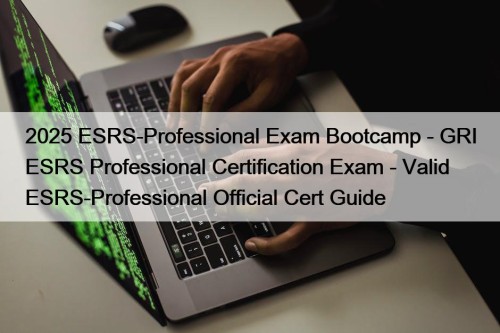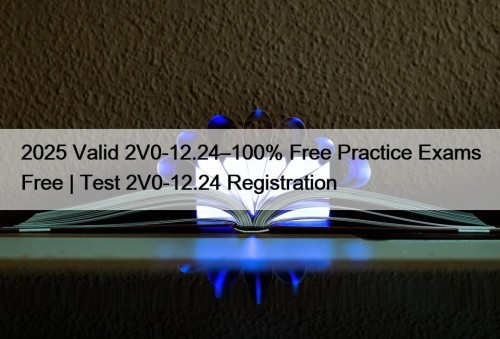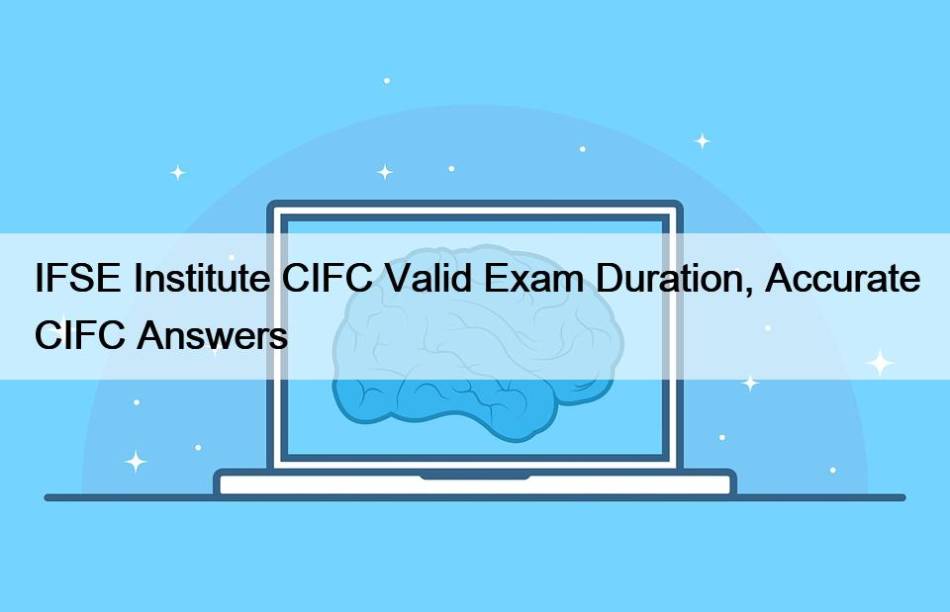Most Popular
 2025 ESRS-Professional Exam Bootcamp - GRI ESRS Professional Certification Exam - Valid ESRS-Professional Official Cert Guide
2025 ESRS-Professional Exam Bootcamp - GRI ESRS Professional Certification Exam - Valid ESRS-Professional Official Cert Guide
Our ESRS Professional Certification Exam (ESRS-Professional) exam dumps are useful ...
 2025 Valid 2V0-12.24–100% Free Practice Exams Free | Test 2V0-12.24 Registration
2025 Valid 2V0-12.24–100% Free Practice Exams Free | Test 2V0-12.24 Registration
Our PDF version is a printable document of exam questions ...
 Salesforce Financial-Services-Cloud Reliable Dumps Questions | Financial-Services-Cloud Vce Exam
Salesforce Financial-Services-Cloud Reliable Dumps Questions | Financial-Services-Cloud Vce Exam
P.S. Free & New Financial-Services-Cloud dumps are available on Google ...



IFSE Institute CIFC Valid Exam Duration, Accurate CIFC Answers

BTW, DOWNLOAD part of Exams4sures CIFC dumps from Cloud Storage: https://drive.google.com/open?id=1-6v2dHT4UU7LK9Ymq2zDI8QR0MQQkkUf
If you are still hesitating about whether you can get CIFC certification through the exam, we believed that our CIFC study materials will be your best choice, it will tell you that passing the exam is no longer a dream for you, and it will be your best assistant on the way to passing the exam. Tens of thousands of our customers have benefited from our CIFC Exam Braindumps and got their certifications. So you will as long as you choose to buy our CIFC practice guide.
IFSE Institute CIFC Exam Syllabus Topics:
| Topic | Details |
|---|---|
| Topic 1 |
|
| Topic 2 |
|
| Topic 3 |
|
| Topic 4 |
|
| Topic 5 |
|
| Topic 6 |
|
| Topic 7 |
|
| Topic 8 |
|
| Topic 9 |
|
| Topic 10 |
|
>> IFSE Institute CIFC Valid Exam Duration <<
Efficient IFSE Institute - CIFC Valid Exam Duration
It is believe that employers nowadays are more open to learn new knowledge, as they realize that IFSE Institute certification may be conducive to them in refreshing their life, especially in their career arena. A professional IFSE Institute certification serves as the most powerful way for you to show your professional knowledge and skills. For those who are struggling for promotion or better job, they should figure out what kind of CIFC test guide is most suitable for them. However, some employers are hesitating to choose. We here promise you that our CIFC Certification material is the best in the market, which can definitely exert positive effect on your study. Our CIFC learn tool create a kind of relaxing leaning atmosphere that improve the quality as well as the efficiency, on one hand provide conveniences, on the other hand offer great flexibility and mobility for our customers. That’s the reason why you should choose us.
IFSE Institute Canadian Investment Funds Course Exam Sample Questions (Q22-Q27):
NEW QUESTION # 22
Your client Gerard is 30 years old and plans to retire at age 65. He has a mutual fund portfolio of $40,000 in which he invests $1,500 monthly. Gerard's objective is to use these funds to meet the 20% down payment requirement to buy a house for $650,000.
What is Gerard's investment time horizon not considering market fluctuations?
- A. 15 years
- B. 25 years
- C. 35 years
- D. 5 years
Answer: D
Explanation:
Explanation
Gerard's investment time horizon is the length of time he plans to hold his investment until he needs to use the money for his specific goal. In this case, Gerard's goal is to use his mutual fund portfolio to meet the 20% down payment requirement to buy a house for $650,000. Therefore, his investment time horizon is determined by how long it will take him to accumulate enough money in his portfolio to cover the down payment amount.
Assuming that Gerard does not withdraw any money from his portfolio and that his portfolio earns a constant annual rate of return of 6%, we can use the following formula to calculate how long it will take him to reach his goal:
FV=PV×(1+r)n+PMT×r(1+r)n1
where:
FV is the future value of the portfolio
PV is the present value of the portfolio
r is the annual interest rate
n is the number of years
PMT is the monthly payment
We can rearrange the formula to solve for n:
n=log(1+r)logPV+PMT×r1FVPMT×r1
Plugging in the given values, we get:
n=log(1+0.06)log40,000+1,500×0.061130,0001,500×0.061
n=4.98
Therefore, Gerard's investment time horizon is approximately 5 years, not considering market fluctuations.
This means that he will need to invest his money in a way that matches his risk tolerance and expected return for this time period.
References:
Canadian Investment Funds Course (CIFC) Study Guide, Chapter 4: Mutual Funds, Section 4.6: Asset Allocation and Diversification, page 4-271 Future Value of an Annuity Definition - Investopedia2
NEW QUESTION # 23
What do Guaranteed Income Supplement (GIS) and Allowance for the Survivor have in common?
- A. ability to defer benefits
- B. benefits start at the age of 65
- C. benefit amounts depend on individual contribution
- D. eligibility depends on income level
Answer: D
Explanation:
Explanation
Guaranteed Income Supplement (GIS) and Allowance for the Survivor are both income-tested benefits that are part of the Old Age Security (OAS) program. They are designed to provide financial assistance to low-income seniors who meet certain eligibility criteria. GIS is a monthly payment that supplements the OAS pension for seniors whose income is below a certain threshold. Allowance for the Survivor is a monthly payment for low-income seniors aged 60 to 64 whose spouse or common-law partner has died and who have not remarried or entered into another common-law relationship. The benefit amounts for both GIS and Allowance for the Survivor depend on the income level of the recipient and are adjusted quarterly based on the Consumer Price Index. The higher the income, the lower the benefit amount, until it reaches zero at a certain income limit.
Therefore, eligibility for both GIS and Allowance for the Survivor depends on income level.
References: Canadian Investment Funds Course, Chapter 5: Registered Plans1
NEW QUESTION # 24
Iliana owns 1,000 participating preferred shares in the First Canadian Bank. Which of the following features are characteristic of her investment?
- A. Iliana has the right to purchase more preferred shares in the company before common shareholders.
- B. Iliana can convert her preferred shares to common shares at a fixed price and within a specified time period.
- C. Iliana has a right to share in the bank's net profits over and above the specified dividend rate.
- D. Iliana is able to vote at the annual general meeting and elect members of the board of directors.
Answer: C
Explanation:
Explanation
Participating preferred shares are a type of preferred shares that give the holder a right to share in the issuer's net profits over and above the specified dividend rate. This means that participating preferred shareholders may receive additional dividends if the issuer performs well. Iliana owns participating preferred shares in the First Canadian Bank, which means she has a right to share in the bank's net profits over and above the specified dividend rate. References: Investment Funds in Canada (IFC) | Canadian Securities Institute
NEW QUESTION # 25
Jonathan is a Dealing Representative who has just finished an appointment with his new client, Shirley.
Jonathan has concluded that Shirley has a low-risk profile but wants to establish additional savings of
$500,000. During their discussion, Shirley emphasizes she wants investments that are also tax efficient.
Jonathan learned that currently Shirley has no registered retirement savings plan (RRSP) and tax-free savings account (TFSA) contribution room due to using those opportunities by investmenting elsewhere.
What variable is a PRIMARY consideration for Jonathan when making an investment recommendation?
- A. The tax consequences.
- B. Expected time horizon.
- C. Investment objective
- D. Shirley's risk profile.
Answer: D
NEW QUESTION # 26
Your client Gerard is 30 years old and plans to retire at age 65. He has a mutual fund portfolio of $40,000 in which he invests $1,500 monthly. Gerard's objective is to use these funds to meet the 20% down payment requirement to buy a house for $650,000.
What is Gerard's investment time horizon not considering market fluctuations?
- A. 15 years
- B. 25 years
- C. 35 years
- D. 5 years
Answer: D
Explanation:
Explanation
Gerard's investment time horizon is the length of time he plans to hold his investment until he needs to use the money for his specific goal. In this case, Gerard's goal is to use his mutual fund portfolio to meet the 20% down payment requirement to buy a house for $650,000. Therefore, his investment time horizon is determined by how long it will take him to accumulate enough money in his portfolio to cover the down payment amount.
Assuming that Gerard does not withdraw any money from his portfolio and that his portfolio earns a constant annual rate of return of 6%, we can use the following formula to calculate how long it will take him to reach his goal:
FV=PV*(1+r)n+PMT*r(1+r)n1
where:
* FV is the future value of the portfolio
* PV is the present value of the portfolio
* r is the annual interest rate
* n is the number of years
* PMT is the monthly payment
We can rearrange the formula to solve for n:
n=log(1+r)logPV+PMT*r1FVPMT*r1
Plugging in the given values, we get:
n=log(1+0.06)log40,000+1,500*0.061130,0001,500*0.061
n=4.98
Therefore, Gerard's investment time horizon is approximately 5 years, not considering market fluctuations.
This means that he will need to invest his money in a way that matches his risk tolerance and expected return for this time period.
References:
* Canadian Investment Funds Course (CIFC) Study Guide, Chapter 4: Mutual Funds, Section 4.6: Asset Allocation and Diversification, page 4-271
* Future Value of an Annuity Definition - Investopedia2
NEW QUESTION # 27
......
Studying from an updated practice material is necessary to get success in the IFSE Institute CIFC certification test on the first try. If you don't adopt this strategy, you will not be able to clear the Canadian Investment Funds Course Exam (CIFC) examination. Failure in the Canadian Investment Funds Course Exam (CIFC) test will lead to loss of confidence, time, and money. Don't worry because "Exams4sures" is here to save you from these losses with its updated and real IFSE Institute CIFC exam questions.
Accurate CIFC Answers: https://www.exams4sures.com/IFSE-Institute/CIFC-practice-exam-dumps.html
- Actual CIFC Test 🧫 CIFC Reliable Test Review 🪐 Actual CIFC Test 🍼 Download ➤ CIFC ⮘ for free by simply entering ▛ www.testsdumps.com ▟ website 🕊CIFC Valid Test Guide
- Free PDF Quiz IFSE Institute - CIFC - Canadian Investment Funds Course Exam High Hit-Rate Valid Exam Duration 🕔 Easily obtain free download of ⮆ CIFC ⮄ by searching on ➥ www.pdfvce.com 🡄 💾CIFC Practice Test Online
- Free PDF Quiz IFSE Institute - CIFC - Canadian Investment Funds Course Exam High Hit-Rate Valid Exam Duration 🎄 Copy URL [ www.examcollectionpass.com ] open and search for ➠ CIFC 🠰 to download for free 😯CIFC Training For Exam
- 2025 Useful CIFC Valid Exam Duration | CIFC 100% Free Accurate Answers 🧣 Download ➽ CIFC 🢪 for free by simply searching on ➤ www.pdfvce.com ⮘ 🧩CIFC Valid Test Guide
- CIFC Reliable Test Review 🩲 CIFC Valid Dumps Ppt 😺 CIFC Valid Learning Materials 🆖 Enter ⏩ www.pass4leader.com ⏪ and search for ▷ CIFC ◁ to download for free 🌞CIFC Reliable Braindumps Ppt
- New CIFC Test Braindumps ⚫ CIFC Reliable Braindumps Ppt 🛬 Actual CIFC Test 🚈 Open 【 www.pdfvce.com 】 enter ➽ CIFC 🢪 and obtain a free download 🏆CIFC Training For Exam
- Free PDF Quiz IFSE Institute - Updated CIFC Valid Exam Duration 🧔 Download ✔ CIFC ️✔️ for free by simply searching on ➥ www.dumpsquestion.com 🡄 🥰CIFC Reliable Test Review
- 2025 IFSE Institute Unparalleled CIFC Valid Exam Duration Pass Guaranteed 🥳 Search for ✔ CIFC ️✔️ and easily obtain a free download on ➥ www.pdfvce.com 🡄 🎼Reliable CIFC Braindumps Sheet
- Online CIFC Test 🗣 CIFC Practice Mock 🐆 Reliable CIFC Exam Cram 😐 Simply search for ✔ CIFC ️✔️ for free download on ➡ www.prep4away.com ️⬅️ 🍟Reliable CIFC Braindumps Sheet
- Reliable CIFC Braindumps Sheet 🦔 Reliable CIFC Study Notes 🤎 Latest CIFC Learning Material 🐣 Simply search for ⮆ CIFC ⮄ for free download on ⏩ www.pdfvce.com ⏪ 🕐CIFC Practice Test Online
- Hot CIFC Valid Exam Duration | High-quality CIFC: Canadian Investment Funds Course Exam 100% Pass ⏬ Open ⇛ www.torrentvce.com ⇚ enter ➥ CIFC 🡄 and obtain a free download 🙆CIFC Practice Test Online
- CIFC Exam Questions
- stockgyan2m.com rawah.org onlinemedicalcodingtraining.com lead.digzi.net lms.uplyx.com courses.sidhishine.com academy.wassimamanssour.com www.infiniteskillshub.com.au courses.sidhishine.com leobroo840.azzablog.com
P.S. Free 2025 IFSE Institute CIFC dumps are available on Google Drive shared by Exams4sures: https://drive.google.com/open?id=1-6v2dHT4UU7LK9Ymq2zDI8QR0MQQkkUf
Tags: CIFC Valid Exam Duration, Accurate CIFC Answers, CIFC Questions, Question CIFC Explanations, Trustworthy CIFC Exam Content